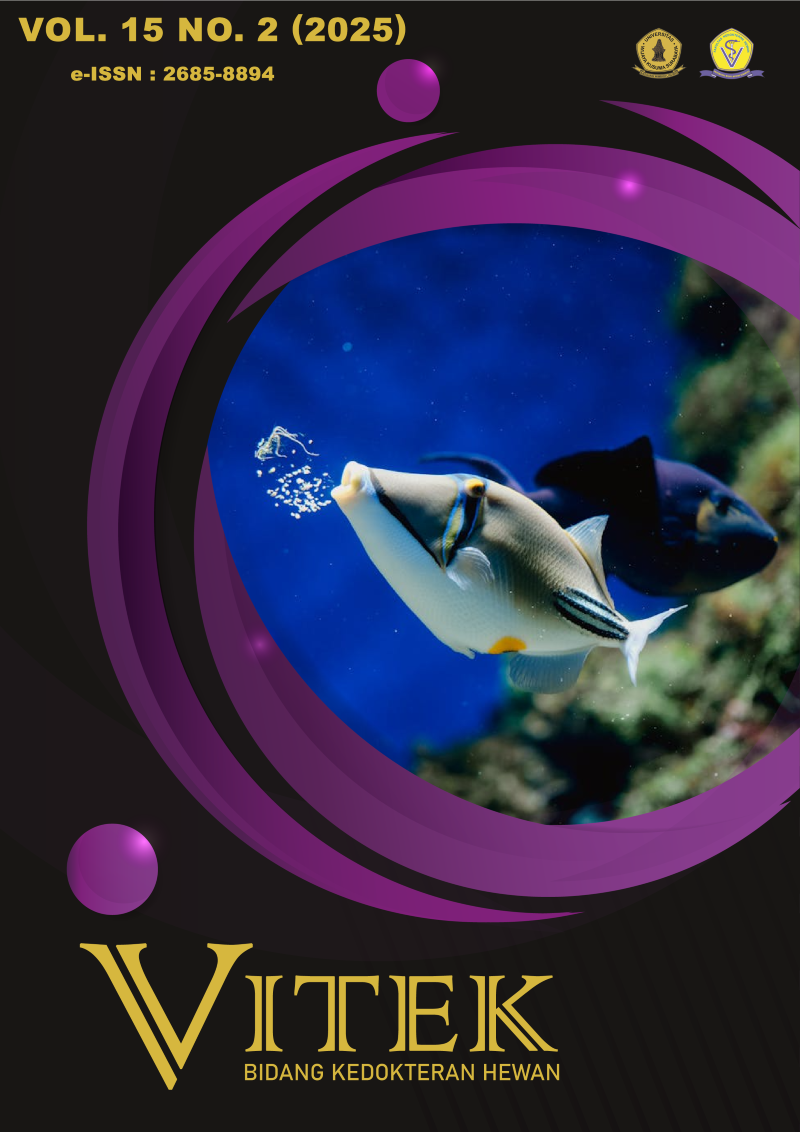Efektivitas Nano Herbal Daun Pepaya (Carica papaya L.) sebagai Antelmintik pada Pengujian In Vitro
Main Article Content
Abstract
Haemonchosis often be found in small ruminants, such as sheep. This is one of the reasons many farmers struggle with economic loss without their knowledge. Lack of knowledge about this disease and repetitive usage of the same anthelmintic could lead to anthelmintic resistance. The use of papaya leaves as an anthelmintic could be an alternative for this matter because they have active ingredients such as tannin, flavonoid, saponin, etc. Using nanotechnology to make this anthelmintic hopefully could alleviate the effect of this herb. Nano herb was made by extracting simplicias, homogenizing the emulsion with a homogenizer, and lastly displaying the emulsion with ultrasonication. The mean z-average of nano herb by Particle Size Analyzer is estimated to be 824,7 nm. In vitro tests with egg hatch assay showed that nano herbs could destroy 41,67% - 100% eggs. Larva motility inhibition test showed all larvae in the microtube were paralyzed in group NH25%. Adult H. contortus showed the earliest time of death at 17 minutes (± 10,12) in group NH25%. These conclude that papaya leaves in nano form could act as an anthelmintic to H. contortus in in vitro testing with the best effect in group NH25%.
Article Details
Section
How to Cite
References
Adak, M., Kumar, P. 2022. Herbal anthelmintic agents: a narrative review. Tradit. Chin. Med., 42(2), 641− 651.
Ahmad, R.Z., Tiffarent, R. 2020. Aspek patologi haemonchosis pada kambing dan domba. Wartazoa., 30(2), 91−102.
Ahmed, A.H., Ejo, M., Feyera, T., Regassa, D., Mummed, B., Huluka, S.A. 2020. In vitro anthelmitntic activity of crude extracts of Artemisia herba-alba and Punica granatum against Haemonchus contortus. J. Parasitol. Res.,1-7.
Arsenopoulos, K.V., Fthenakis, G.C., Katsarou, E.I. 2021. Haemonchosis: a challenging parasitic infection of sheep and goats. Animals, 11(2), 363.
Bonifácio, B.V., da Silva, P.B., dos Santos Ramos, M.A., Negri, K.M.S, Bauab, T.M., Chorilli, M. 2014. Nanotechnology-based drug delivery systems and herbal medicines: a review. Int. J. Nanomedicine, 9, 1−15.
Bora, A.M.A.B, Samsuri, Oka, I.B.M. 2014. Vermisidal dan ovisidal ekstrak daun pepaya terhadap cacing Ascaris suum secara in vitro. Indones. Med. Veterinus. 3(2), 84-91.
Cabardo, Jr. D.E., Portugaliza, H.P. 2017. Anthelmintic activity of Moringa oleifera seed aqueous and ethanolic extracts against Haemonchus contortus eggs and third stage larvae. Int. J. Vet. Sci., 5(1), 30–34.
Davuluri, T., Chennuru, S., Pathipati, M., Krovvidi, S. 2020. In vitro anthelmintic activity three tropical plant extracts on Haemonchus contortus. Acta. Parasitol., 65(1): 11−18.
Dewandari, K.T., Yuliani, S., Yasni. 2013. Ekstraksi dan karakterisasi nanopartikel ekstrak sirih merah (Piper crocatum). J. Penelit. Pascapanen., 58−65.
Fitrine, E., Dewi, D.A., Suhardono, Sawitri, D.H., Martindah, E., Wardhana, A.H. 2022. Aktivitas ovisidal, larvisidal, dan vermisidal ekstrak herbal terhadap nematoda Haemonchus contortus secara in-vitro. Jurnal Veteriner., 23(2): 146−156.
Islam, M.R., Tuz Zahra, S.F., Sumon, S.M., Parvin, S., Hasan, K., Ahmed, M., Siddique, M.A.T., Haque, T. 2019. Evaluation of anthelmintic activity of ethanolic extracts of Carica papaya leaves using Paramphistomum cervi and Haemonchus contortus. AJPP., 13(12), 146−150.
Joshi, B.R., Kommuru, D.S., Terrill, T.H., Mosjidis, J.A., Burke, J.M., Shakya, K.P., Miller, J.E. 2010. Effect of feeding sericea lespedeza leaf mealin goats experimentaly infected with Haemonchus contortus. Vet. Parasitol., 178(1), 192-197.
Kiswandono, A.A. 2017. Skrining senyawa kimia dan pengaruh metode maserasi dan refluks pada biji kelor (Moringa oleifora, Lamk) terhadap rendemen ekstrak yang dihasilkan. JSN. 1(2), 126−134.
Mahatriny, N.N, Payani, N.P.S, Oka, I.B.M, Astuti, K.W. 2014. Skrining fitokimia ekstrak etanol daun papaya (Carica papaya L.) yang diperoleh dari daerah Ubud, Kabupaten Gianyar, Bali. J. Farm. Udayana., 3(1), 8−13.
Mini, K.P. 2012. In vitro assessment of anthelmintic effect of Arstolochia species plants against Haemonchus contortus [disertasi]. Chennai: Tamil Nadu Veterinary and Animal Sciences University.
Mossalei, N., Jaafari, M.R., Hanafi-Bojd, M.Y., Golmohammdzade, S., Malaekeh-Nikouei B. 2013. Docetaxel-loaded solid lipid nanoparticles: preparation, characterization, in vitro, and in vivo evaluations. J. Pharm. Sci., 102(6), 1994−2004.
Mujib, M.A. 2011. Pencirian nanopartikel kurkuminoid tersalut lemak padat [tesis]. Bogor: Institut Pertanian Bogor.
Musthaba, S.M., Baboota, S., Ahmed, S., Ahuja, A., Ali, J. 2009. Status of novel drug delivery technology for phytotherapeutics. Expert. Opin. Drug. Deliv. 6(6), 625−637.
Odhong, C., Wahome, R.G., Vaarst, M., Nalubwama, S., Kiggundu, M., Halberg, Githigia, S. 2015. In vitro anthelmintic effects of crude aqueous extracts of Tephrosia vogelii, Tephrosia villosa, and Carica papaya leaves and seeds. Afr. J. Biotechnol., 13(52), 4667−4672.
Oktofani, L.A., Suwandi, J.F. 2019. Potensi tanaman pepaya (Carica papaya) sebagai antihelmintik. Majority. 8(1), 246−250.
Senduk, T.W., Montolalu, L.A., Dotulong, V. 2020. Rendemen ekstrak air rebusan daun tua Mangrove Sonneratia alba. JPK., 11(1), 9−15.
Soulsby, E.J.L. 1986. Helminths, Arthropods & Protozoa of Domesticated Animals 7th Edition. London: Bailliere Tindall.
Widiarso, B.P., Kurniasih, K., Prastowo, J., Nurcahyo, W. 2018. Morphology and morphometry of Haemonchus contortus exposed to Gigantochloas apus crude aqueous extract. Vet. World., 107, 57-65.
Yen, F.L., Wu, T.H., Lin, L.T., Cham, T.M., Lin, C.C. 2008. Nanoparticles formulation of Cucuta chinensis prevents acetaminophen-induced hepatotoxicity in rats. FCT. 46, 1771−1777.

